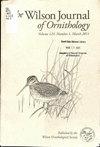Ornithological Literature
IF 0.5
4区 生物学
Q4 ORNITHOLOGY
引用次数: 0
Abstract
Apart from the small Old World family Eurylaimidae (the broadbills), of which 8 genera and 14 species are recognized, the seventh volume of Peters’ monumental check-list of the birds of the world, the publication of which has now been taken over by the Museum of Comparative Zoizilogy, is devoted entirely to neotropical families of the superfamily Furnarioidea, including the wood-hewers (Dendrocolaptidae), ovenbirds (Furnariidae), ant-thrushes (Formicariidae): ant-pipits (Conopophagidae) and tapaculos (Rhinocryptidae). No species in this group has been recorded from North America north of Mexico. Since these New World families were monographed by the late eminent ornithologist Dr. C. E. Hellmayr less than 30 years ago, a comparison of the two works is pertinent. Important changes include the elimination of subfamilies, a decrease in the number of species (527 vs. 540), and a great increase in the number of recognized forms (1581 vs. 1163). Several genera have been removed from the Formicariidae, Melanopareia being placed in the Rhinocryptidae, while Psilorhampkz~s, in addition to Ranzphocaenus anti Microbates, are referred to the Sylviidae. Of the genera we note that “Dendroplex ” is merged with Xiphorhynchus, “Dendrophylax” with Leptasthenura, “Drioctistes” with Phacellodomus, “Microxenops” with Xenops, “Apocryplornis” with Grallaricula. Six genera (Oclzetorl~ynclzus, Spartonoica, Hellmayrea, Gyalophylas, Roraimia, and Simoxenojx) are added to the Furnariidae, two (Xenovnis and iMyrmop/cyZax) to the Formicariidae. This reviewer is impressed not only with the standard of accuracy and attention to details characteristic of Peters’ work, but also with his conservative taxonomic treatment in contrast with the works of certain other authors.-James Bond.鸟类学的文学
除了旧大陆的阔嘴鸟科(阔嘴鸟科)有8属14种被确认外,彼得斯的《世界鸟类名录》第七卷(现在已由比较动物学博物馆接管出版)完全是关于阔嘴鸟总科的新热带科,包括伐木鸟(树蕨科)、火炉鸟(阔嘴鸟科)、画眉鸟(蚁蛉科)。蚁蜂(锥蝽科)和锥蝽(鼻蝽科)。在墨西哥以北的北美地区没有记录到这一类群的物种。由于这些新世界的家庭是由已故的著名鸟类学家c.e. Hellmayr博士在不到30年前撰写的专著,因此对这两部作品进行比较是有意义的。重要的变化包括亚科的消失、物种数量的减少(527种对540种)和已知形式数量的大幅增加(1581种对1163种)。有几个属已经从蚁科中移除了,Melanopareia被放在了Rhinocryptidae中,而Psilorhampkz~s和Ranzphocaenus anti Microbates被归入了Sylviidae。我们注意到,“Dendroplex”与Xiphorhynchus合并,“dendrophyllax”与Leptasthenura合并,“Drioctistes”与Phacellodomus合并,“Microxenops”与Xenops合并,“Apocryplornis”与Grallaricula合并。螨科新增6属(Oclzetorl~ynclzus、Spartonoica、Hellmayrea、Gyalophylas、Roraimia、Simoxenojx),螨科新增2属(Xenovnis和imymrmop /cyZax)。这位评论家不仅对彼得斯作品的准确性标准和对细节的关注印象深刻,而且与其他某些作者的作品相比,他的分类处理也很保守。——詹姆斯邦德。
本文章由计算机程序翻译,如有差异,请以英文原文为准。
求助全文
约1分钟内获得全文
求助全文
来源期刊
CiteScore
0.90
自引率
0.00%
发文量
133
审稿时长
4-8 weeks
期刊介绍:
Aims & Scope
For more than a century, the Wilson Ornithological Society has published a scholarly journal with form and content readily accessible to both professional and amateur ornithologists. The Wilson Journal of Ornithology is a quarterly publication consisting of major articles based on original studies of birds and short communications that describe observations of particular interest. Each issue also includes reviews of new books on birds and related subjects, as well as ornithological news. Through an endowment from the late George Miksch Sutton, each issue of the Journal includes a full color frontispiece. Each current volume consists of approximately 500 pages. The principal focus of the Journal is the study of living birds, their behavior, ecology, adaptive physiology and conservation.
Although most articles originate from work conducted in the western hemisphere (a large portion of the research on Neotropical birds is published here), the geographic coverage of the journal is global. The Journal is internationally recognized as an important, major journal of ornithology. The Edwards Prize is given annually for the best major article published during the previous year.
The Wilson Journal of Ornithology was formerly named the Wilson Bulletin.

 求助内容:
求助内容: 应助结果提醒方式:
应助结果提醒方式:


